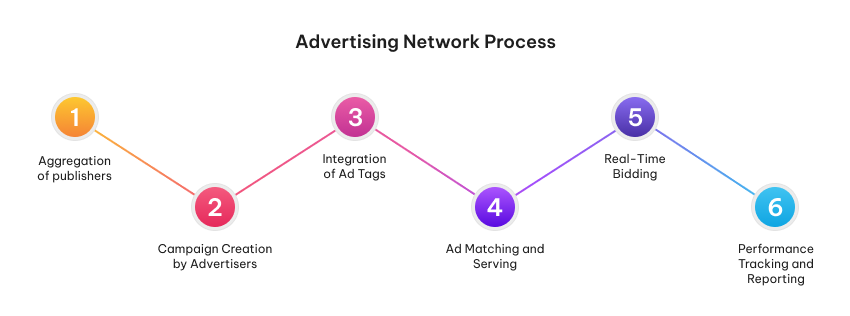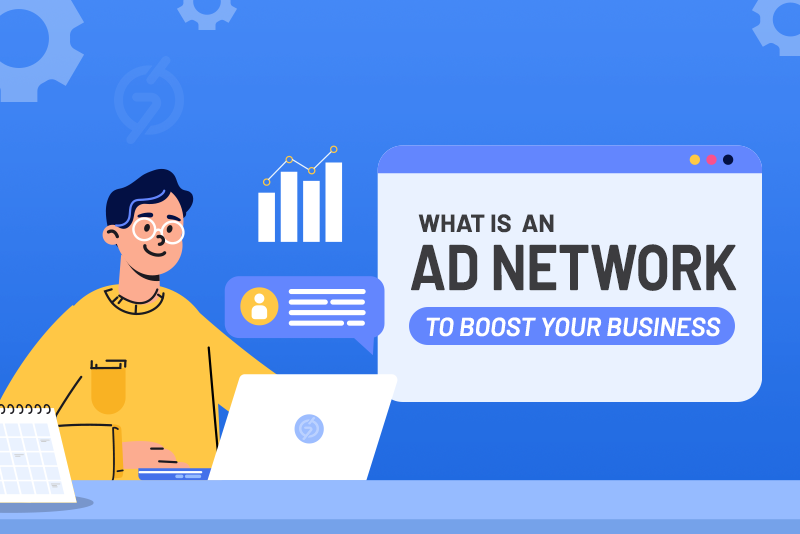Whether you are an advertiser planning your next big campaign or a publisher looking to monetize your blog, knowing the nuts and bolts of an ad network makes a real difference. It’s not just about choosing a platform; it’s about understanding how it works, what it offers, and how it aligns with your goals.
Advertising networks are not what they used to be. They’ve evolved, offering smarter tools, better targeting, and more ways to connect with the right audience. The more you are aware of what is under the hood, the better you can navigate this space and make the most of every opportunity.
In this blog, we will explore everything you need to know about ad networks. We are here to help both publishers and advertisers achieve better results.
Advertising Networks: Everything You Should Know to Get Started!
Understanding advertising networks is crucial for achieving better reach and revenue. They are platforms that allow advertisers to promote their business products and services. At the same time, enabling publishers to make money by running ads from advertisers on their websites. Moreover, an ad network simplifies the process of buying and selling ad space by acting as a mediator.
Overall, ad networks enable advertisers to reach a wider audience and publishers to monetize their content. Thus, advertisers and publishers connect through advertising networks for mutual success.
How do Ad Networks Work?
It’s crucial to be aware of how ad networks work. We have mentioned some points that will help you with this.

Partnering with Publishers
Advertising networks grow by attracting various publishers or website owners who want to monetize their traffic. These publishers sign up with the networks and share their available ad inventory or ad spaces.
Advertising Campaign Planning
When advertisers join the ad network, they need to plan their ad campaign, which includes the following steps;
- Setting campaign objectives (e.g., awareness, traffic, conversions)
- Defining the target audience (based on factors like location, age, interests, etc.)
- Choosing ad formats (display, video, native, etc.)
- Setting a budget and bidding strategy
Integration of Ad Tags by Publishers
Ad tags are crucial for publishers, as they are codes provided by the ad network. When they implement ad tags into their websites, it enables the advertising network to serve online ads.
These advertisements are based on parameters such as user behavior and content relevance specified by advertisers.
Ad Matching and Placement
The advertising network connects an advertiser’s campaign to the ideal publisher’s inventory. Once this perfect match is established, the advertising network efficiently delivers the ad directly to the publisher’s site.
Publishers can strategically place these ads where they feel they will receive more engagement, such as in the header, sidebar, inside the content, etc., thus benefiting both parties.
Real-Time Bidding
In many ad networks, particularly those utilizing programmatic advertising, real-time bidding (RTB) is employed. In RTB, advertisers bid for impressions in real-time, and the highest bidder’s ad is displayed to the user instantly.
Real-time bidding lets publishers sell ad space automatically to the highest bidder, helping them earn more money and have better control over their ads.
Performance Tracking and Management
Once an advertising campaign is active, advertisers can track and improve its performance via the ad network. This involves monitoring metrics such as impressions, clicks, and conversions to enhance the campaign’s effectiveness by adjusting targeting or budget.
Meanwhile, publishers can analyze the ads shown on their sites. The platform provides detailed data on impressions, click-through rates, and earnings, allowing publishers to identify top-performing ads and increase their revenue.
Different Types of Advertising Networks
There are different types of advertising networks available, some of which include,

Vertical Advertising Network
This ad network is well-known among advertisers seeking to reach their target audience efficiently. The ad network focuses on specific niches, including iGaming, dating, and adult industries.
Vertical Advertising Network allows advertisers to target their ads precisely, helping them reach the ideal audience who is highly interested in their offering. This also benefits publishers by offering targeted advertising within specific niches, improving ad relevance and engagement.
It enhances monetization by connecting publishers with advertisers who are focused on their target audience, leading to improved ad revenue and a more optimized user experience.
Horizontal Advertising Network
Compared to vertical advertising networks, horizontal ad networks offer greater reach and a more diverse audience. They operate across multiple websites with various niches available.
Targeting with this advertising network is less precise, but advertisers can get the best traffic on their platform. They focus on a specific industry or vertical, like:
- General News & Media
- Entertainment
- Lifestyle & Fashion
- Technology & Gadgets
- Health & Fitness
A horizontal advertising network also helps publishers by connecting them with diverse advertisers across industries, increasing ad fill rates, boosting revenue, and simplifying ad management.
Premium Advertising Network
With the name, you guessed it right: premium advertising networks are exclusive for both advertisers and publishers. These networks select high-quality ad placements from reputable websites with large audiences.
They have a strict rule for publishers, as not just anyone can enroll on their platform. This benefits advertisers, as they receive high-quality traffic with a good chance of making money. However, advertisers must be aware that they have to pay more.
Inventory-Specific Advertising Network
This advertising network focuses on selling and managing a specific set of publishers’ inventory. Many ad networks serve ads across a wide range of digital spaces. This ad network works closely with top publishers, ensuring higher relevance and more controlled ad placements.
This enables publishers to get better monetization opportunities because their ad inventory gets sold at higher rates due to its defined audience.
For advertisers, it offers the best targeting and brand exposure, improving performance metrics because ads are placed in a trusted, contextually relevant way.
Targeted Advertising Network
Lastly, a targeted advertising network helps publishers by automatically displaying relevant ads that generate higher engagement and revenue. On the other hand, it helps advertisers deliver their ads to the right audience, improving ROI through better targeting and performance tracking.
These ad networks use advanced technology for effective ad targeting, delivering ads to users based on various factors like;
- Demographics
- Browsing Behavior
- Interests
- Purchase History
How do Advertising Networks Benefit Advertisers and Publishers?
An ad network plays a crucial role in the digital advertising ecosystem. Some benefits of it include,
Benefits for Advertisers:
Wider Reach
One of the key benefits of advertising networks is their extensive reach. The ad network has access to the best publishers that help your ads reach the widest audience.
Cost-Effective Advertising
Running an ad campaign with the ad network will be a cost-effective solution for you. Ad networks give advertisers flexibility and full control over their campaigns and budgets. You can also select your preferred pricing model.
Campaign Management and Optimization
Ad networks make it easy for advertisers to perform well, as they provide them with user-friendly dashboards for managing their ad campaigns. Through which they can track their performance and adjust their advertising strategies.
Benefits for Publishers:
Revenue Generation
Earning money becomes easier for publishers with the right ad network because it aligns with their content, audience, and goals, ensuring a smoother and more efficient monetization process.
High Ad Fill Rates
Advertising networks help publishers easily fulfill their ad space with the best ads, as many publishers face challenges when attempting to sell their ad inventory. It overall helps the publisher make the best money.
Quick Withdrawal
When you choose the best advertising network, it offers on-time payouts to ensure publishers receive their earned revenue easily. This consistent and predictable income stream helps publishers manage their cash flow effectively.
Join 7SearchPPC: A Trusted Partner for Publishers and Advertisers
Whether you are an advertiser looking to increase your reach and maximize ROI or a publisher seeking ways to monetize your website, achieving these goals depends on selecting the right advertising network.
7SearchPPC is the ad network perfectly suited for your goals, as it helps both advertisers and publishers achieve the results they have been looking for.
Some of the benefits they both receive when choosing 7SearchPPC,
For Advertisers:
- High-quality traffic with targeted reach
- Ads Scheduling
- Transparent performance tracking and real-time analytics
- 24/7 dedicated support to ensure smooth campaign execution
- Access to the best ad formats
For Publishers:
- Better payouts with competitive revenue share
- High-quality, relevant ads
- Easy-to-implement and safe ad codes
- Secure and compliant ad formats
- 24/7 support to assist with any issues or queries
Final Outcome
Advertising networks are beneficial platforms that streamline the online advertising process for both advertisers and publishers. Publishers benefit from advertising networks by monetizing unsold ad inventory, simplifying ad management, and receiving on-time payments.
Advertisers benefit from ad networks to reach a broader target audience, lower their advertising costs, and get better results from their ad campaigns.
Frequently Asked Questions (FAQs)
What do you mean by advertising network?
Ans: An ad network is a platform that enables advertisers to promote their products and services, and publishers display advertisers’ ads on their websites. It helps both by offering them the result they have been looking to achieve.
What are the different types of advertising networks?
Ans: There are different types of advertising networks available, some of which include,
- Vertical Advertising Network
- Horizontal Advertising Network
- Premium Advertising Network
- Inventory-Specific Advertising Network
- Targeted Advertising Network
Which advertising network is best?
Ans: When looking for the best advertising network, 7SearchPPC is the perfect choice. It helps both advertisers and publishers achieve better results.
How much money can publishers make with advertising networks?
Ans: The publisher’s earnings will depend on factors like website traffic, ad format, and niche. To earn a substantial income, focus on selecting the most effective advertising network.
How do advertising networks benefit advertisers?
Ans: Advertisers gain many benefits from choosing an advertising network, including wider reach, cost-effective solutions, and easy campaign management and optimization.
Is there any difference between an ad network and an ad exchange?
Ans: Yes, they both are different. Ad networks are platforms that allow advertisers to promote their products and services by running ads while allowing publishers to display these ads on their websites.
When discussing ad exchanges, they are online platforms that facilitate the buying and selling of digital advertising space, where publishers meet with advertisers, dealing directly with each other without a middleman.
What is the difference between affiliate marketing and advertising?
Ans: There is a significant difference between affiliate marketing and advertising. Affiliate marketing involves individuals/businesses promoting products through unique links or codes, paying affiliates a commission for purchases made using them.
Advertising helps businesses promote their products and services effectively, but it often requires a higher upfront cost. In contrast, affiliate marketing allows businesses to spend only when they make a profit.

















